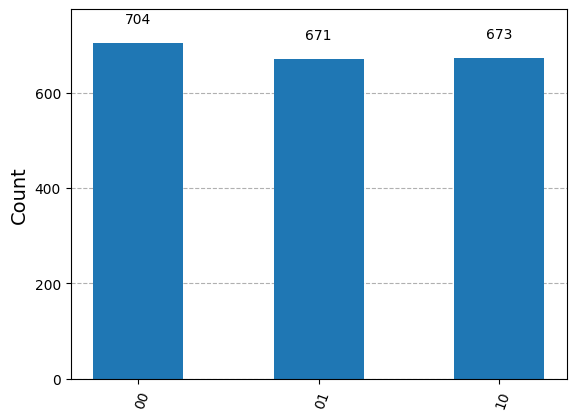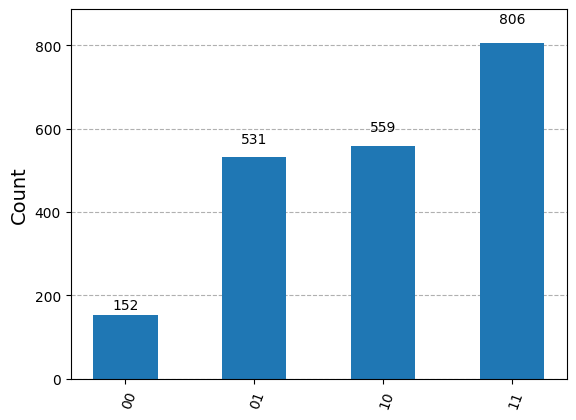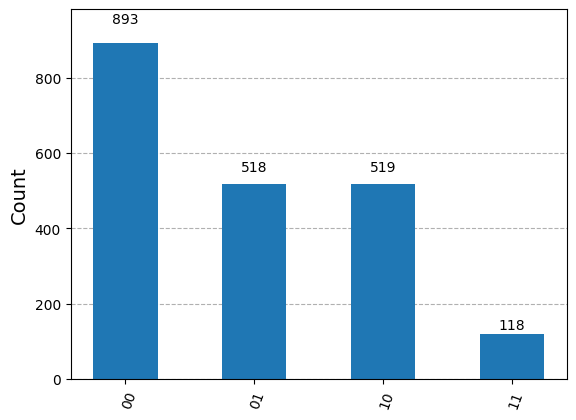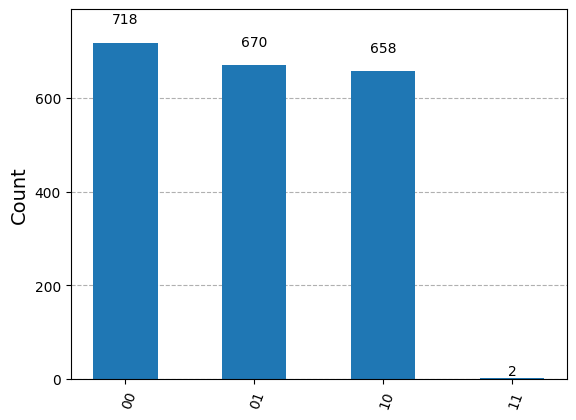from bloqade import start
from bloqade.constants import RB_C6
from qutip import sigmax, basis, mesolve, tensor, Qobj
import numpy as np
from util import zero, one, pretty, plot_histogram, histogram_final_state, invert_keys
Neutral Atom Quantum Computing#
In this notebook, we will introduce Neutral Atom Quantum Computing. Neutral Atom QC uses properties of Rydberg atoms to implement quantum computations.
Rydberg Atoms#
A Rydberg atom is any atom that has one or more excited electrons whose distance (on average) from the nucleus is large. This means that a Rydberg atom placed in proximity to another one can have excited electrons that can interact with another to exhibit quantum effects such as entanglement. The ground state of a Rydberg atom is notated \(\ket{g}\) and the excited state is notated \(\ket{r}\). We can encode
\(\ket{0} = \ket{g}\)
\(\ket{1} = \ket{r}\)
to perform quantum computations with Rydberg atoms.
Rubidium Atoms#
The Aquila neutral atom quantum computer [3] [4] uses Rubidium (Rb37) atoms as its implementation of a Rydberg atom. In the example below, we have place 4 Rydberg atoms on a tabletop.
register = start.add_position([
(0, 0), # 1
(5, 0), # 2
(0, 5), # 3
(5, 5), # 4
]) # (um)
print(register)
Atom Positions
┌──────────────────────────────────────────────────────────────────────────┐
5.00┤• •│
│ │
│ │
4.17┤ │
│ │
│ │
3.33┤ │
│ │
│ │
2.50┤ │
│ │
│ │
1.67┤ │
│ │
│ │
0.83┤ │
│ │
│ │
0.00┤• •│
└┬─────────────────┬──────────────────┬─────────────────┬─────────────────┬┘
0.0 1.2 2.5 3.8 5.0
y (um) x (um)
In the above, we have 4 Rydberg atoms
Rydberg Hamiltonian#
Rydberg atoms are governed by the Rydberg Hamiltonian. We’ll begin with a 1 qubit example of a Rydberg Hamiltonian before working our way to the general case.
Single Qubit#
The Rydberg Hamiltonian on a single qubit (i.e., Rydberg atom) is given as
where
\(\Omega(t)\) is a Rabi frequency,
\(\phi(t)\) is the Rabi phase, and
\(\Delta(t)\) is the detuning of the driving laser.
def H_couple1(Omega, phi, t):
return Omega(t)/2 * Qobj(np.array([
[0.0, np.exp(1j * phi(t))],
[np.exp(-1j * phi(t)), 0.0],
]))
def H_detune1(Delta, t):
return Qobj(np.array([
[0.0, 0.0],
[0.0, Delta(t)],
]))
def H_rydberg1(Omega, phi, Delta, t):
return H_couple1(Omega, phi, t) - H_detune1(Delta, t)
Pauli-X Gate#
We can encode a Pauli-X gate with a Rydberg Hamiltonian.
Omega = lambda t: 2
phi = lambda t: 0
Delta = lambda t: 0
sigma_x = H_rydberg1(Omega, phi, Delta, 0)
pretty(sigma_x.full())
Notice that we have recreated the Hamiltonian for a Pauli-X (up to a scale).
pretty(sigmax().full())
RX_gate = (-1j * sigma_x * np.pi/2).expm()
pretty(RX_gate.full())
We can adjust the phase picked up by the Hamiltonian by adjusting \(\phi\).
Omega = lambda t: 2
phi = lambda t: 3*np.pi/2
Delta = lambda t: 0
X = H_rydberg1(Omega, phi, Delta, 0)
pretty(X.full())
Bloqade#
Bloqade gives us a Python interface to neutral atom quantum hardware. We can write a program for neutral atom quantum hardware by writing down the Rydberg Hamiltonian. To do this, we specify qubits by placing them on \((x, y)\) locations on a 2D plane. We then control the computation by specifying \(\Omega(t)\), \(\phi(t)\), and \(\Delta(t)\) as waveforms that encode the time-dependent signals.
T = np.pi
register = start.add_position([(0, 0)]) # (um)
program = (
register
.rydberg.rabi.amplitude.uniform.piecewise_constant( # Omega = lambda t: 15
durations=[T],
values=[15]
)
.rydberg.rabi.phase.uniform.piecewise_constant( # phi = lambda t: 0
durations=[T],
values=[0]
)
.rydberg.detuning.uniform.piecewise_constant( # Delta = lambda t: 0
durations=[T],
values=[0]
)
)
print(program)
Routine
Atom Positions
┌─────────────────────────────────────────────────────────────────────────┐
1.00┤ │
│ │
│ │
0.67┤ │
│ │
│ │
0.33┤ │
│ │
│ │
0.00┤ • │
│ │
│ │
-0.33┤ │
│ │
│ │
-0.67┤ │
│ │
│ │
-1.00┤ │
└┬─────────────────┬─────────────────┬─────────────────┬─────────────────┬┘
-1.00 -0.50 0.00 0.50 1.00
y (um) x (um)
Sequence
└─ RydbergLevelCoupling
⇒ Pulse
├─ RabiFrequencyAmplitude
│ ⇒ Field
│ └─ Drive
│ ├─ modulation
│ │ ⇒ UniformModulation
│ └─ waveform
│ ⇒ Constant
│ ├─ value
│ │ ⇒ Literal: 15
│ └─ duration
│ ⇒ Literal: 3.141592653589793
├─ RabiFrequencyPhase
│ ⇒ Field
│ └─ Drive
│ ├─ modulation
│ │ ⇒ UniformModulation
│ └─ waveform
│ ⇒ Constant
│ ├─ value
│ │ ⇒ Literal: 0
│ └─ duration
│ ⇒ Literal: 3.141592653589793
└─ Detuning
⇒ Field
└─ Drive
├─ modulation
│ ⇒ UniformModulation
└─ waveform
⇒ Constant
├─ value
│ ⇒ Literal: 0
└─ duration
⇒ Literal: 3.141592653589793
---------------------
> Static params:
> Batch params:
- batch 0:
> Arguments:
()
results = program.bloqade.python().run(1000)
report = results.report()
invert_keys(report.counts())
[OrderedDict([('1', 1000)])]
General Case#
The Rydberg Hamiltonian in the general case is given as
Compared to the single qubit case, we will have a generalization of \(H_\text{coupling}\) and \(H_\text{detune}\) as well as an additional term \(H_\text{interaction}\) that will enable us to entangle qubits. We’ll go over each term now.
Coupling Term#
The term
decribes the strength of the coupling between the ground state \(\ket{g_j}\) and the excited state \(\ket{r_j}\).
The notation \(|g_j\rangle \langle r_j| = I(j-1) \otimes |g\rangle\langle r| \otimes I(n - j - 1)\) selects the \(j\)-th qubit.
\(\Omega_j(t)\) gives the Rabi frequency as a function of time.
\(\phi_j(t)\) gives the Rabi phase as a function of time.
def mk_H_couple(n, Omega, phi):
sigma_x = Omega / 2 * (np.exp(1j * phi) * np.outer(zero, one) + np.exp(-1j * phi) * np.outer(one, zero))
H = np.zeros((2**n, 2**n), dtype=np.complex128)
for j in range(n):
if j == 0:
H += np.kron(sigma_x, np.eye(2**(n-1)))
elif j == n - 1:
H += np.kron(np.eye(2**(n-1)), sigma_x)
else:
H += np.kron(np.eye(2**j), np.kron(sigma_x, np.eye(2**(n-j-1))))
return H
Omega = 15
phi = 0
H_couple = mk_H_couple(2, Omega, phi)
pretty(H_couple)
Coupling as \(\sigma_x\)#
We can rewrite
where
\(\sigma_x^j\) is the Pauli-X gate applied to the \(j\)-th qubit and
\(|g_j\rangle \langle r_j| = I(j-1) \otimes |g\rangle\langle r| \otimes I(n - j - 1)\) selects the \(j\)-th qubit.
Thus we can think of the coupling term as applying \(\sigma_x\) to each qubit.
Detuning Term#
The detuing term is defined as
where \(\hat{n}_j = |r_j\rangle\langle r_j|\) is the number operator.
def nhats(n: int, j: int) -> np.ndarray:
oo_op = np.outer(one, one)
if j == 0:
return np.kron(oo_op, np.eye(2**(n-1)))
elif j == n - 1:
return np.kron(np.eye(2**(n-1)), oo_op)
else:
return np.kron(np.eye(2**j), np.kron(oo_op, np.eye(2**(n-j-1))))
def mk_H_detune(n: int, Delta: float) -> np.ndarray:
H = np.zeros((2**n, 2**n), dtype=np.complex128)
for j in range(n):
H += nhats(n, j)
return Delta * H
# Detune
Delta = -15
H_detune = mk_H_detune(2, Delta)
pretty(H_detune)
Van-dar Waals Interaction Term#
The final term is the interaction term
where
and \(x_j\) and \(x_k\) are atom positions. This term, when combined with the phenomenon of the Rydberg bloqade, is what enables us to create entangled qubits.
register = start.add_position([
(0, 0), # (um)
(5, 0) # (um)
])
print(register)
Atom Positions
┌─────────────────────────────────────────────────────────────────────────┐
1.00┤ │
│ │
│ │
0.67┤ │
│ │
│ │
0.33┤ │
│ │
│ │
0.00┤• •│
│ │
│ │
-0.33┤ │
│ │
│ │
-0.67┤ │
│ │
│ │
-1.00┤ │
└┬─────────────────┬─────────────────┬─────────────────┬─────────────────┬┘
0.0 1.2 2.5 3.8 5.0
y (um) x (um)
V_jk = register.rydberg_interaction()
V_jk
array([[ 0. , 0. ],
[346.90823249, 0. ]])
def interaction_strength(x, y):
return RB_C6 / np.linalg.norm((x - y)) ** 6
interaction_strength(np.array([0, 0]), np.array([5, 0]))
346.90823248964847
def mk_H_interaction(n, register):
V_jk = register.rydberg_interaction()
H_interaction = np.zeros((2**n, 2**n), dtype=np.complex128)
for row in range(0, n):
for col in range(0, row+1):
if row != col:
print(row, col)
H_interaction += V_jk[row, col] * nhats(n, col) @ nhats(n, row)
return H_interaction
H_interaction = mk_H_interaction(2, register)
pretty(H_interaction)
1 0
Putting it together#
We can finally put together the Rydberg Hamiltonian
def mk_H_Rydberg(n, Omega, phi, Delta, register):
H_couple = mk_H_couple(n, Omega, phi)
H_detune = mk_H_detune(n, Delta)
H_interaction = mk_H_interaction(n, register)
return H_couple - H_detune + H_interaction
H_rydberg = mk_H_Rydberg(2, Omega, phi, Delta, register)
pretty(H_rydberg)
1 0
Two Qubit Case#
Written out, the two qubit case is
Bloqade Simulation#
We can simulate the Rydberg Hamiltonian using Bloqade.
def simple_prog(register, T=np.pi/2):
program = (
register
.rydberg.rabi.amplitude.uniform.piecewise_constant( # Omega = lambda t: 15
durations=[T],
values=[15]
)
.rydberg.rabi.phase.uniform.piecewise_constant( # phi = lambda t: 0
durations=[T],
values=[0]
)
.rydberg.detuning.uniform.piecewise_constant( # Delta = lambda t: 0
durations=[T],
values=[0]
)
)
return program
register = start.add_position([(0,0), (5,0)]) # (um)
results = simple_prog(register).bloqade.python().run(2048)
report = results.report()
plot_histogram(invert_keys(report.counts()))

Rydberg Blockade#
The Rydberg Blockade is a phenomenon where an excited state of one qubit prevents another nearby qubit from being excited, thus producing the effect of entanglement. In the example above, we “rarely” observed the outcome \(\ket{11}\) due to the blockade mechanism. Mathematically, we saw that the distance between the atoms affected the Hamiltonian through the interaction term. The blockade radius is defined as
When the distance between two atoms is less than \(R_\text{blockade}\), the excited state of one atom will block the other from getting excited. Outside of \(R_\text{blockade}\), each atom will have less and less of an effect.
def bloqade_radius(Omega):
return (RB_C6 / Omega) ** (1/6)
print("Bloqade radius", bloqade_radius(Omega), "um")
Bloqade radius 8.439639489080086 um
Outside of blockade radius#
register = start.add_position([(0,0), (8.7, 0)]) # (um)
results = simple_prog(register).bloqade.python().run(2048)
report = results.report()
plot_histogram(invert_keys(report.counts()))

Within blockade radius#
register = start.add_position([(0,0), (8.42, 0)]) # (um)
results = simple_prog(register).bloqade.python().run(2048)
report = results.report()
plot_histogram(invert_keys(report.counts()))

Qutip Simulation#
As before, we can also use qutip to solve Schrödinger’s equation.
T = np.pi/2
times = np.linspace(0, T, 100)
register = start.add_position([(0,0), (5,0)]) # (um)
H_rydberg = mk_H_Rydberg(2, Omega, phi, Delta, register)
z = basis(2, 0)
result = mesolve(Qobj(H_rydberg, dims=[[2, 2], [2, 2]]), tensor(z, z), times, [], [])
pretty(result.final_state)
1 0
plot_histogram(histogram_final_state(result.final_state.full()))

Summary#
We introduced neutral atom quantum computing based on Rydberg atoms.
We introduced the Rydberg Hamiltonian and gave a few examples.
We examined the Rydberg Blockade mechanism which enables nearby qubits to interact with each other.
References#
[2] Rydberg Blockade
